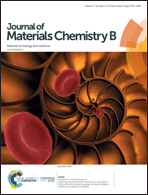A PEG-b-poly(disulfide-l-lysine) based redox-responsive cationic polymer for efficient gene transfection†
Abstract
Gene therapy is concerned with the transfer of complement genes to functionally defective cells in a safe and directed manner for the treatment of the most challenging diseases. But safety issues and low transfection efficiency of the gene vectors are the major challenges, which need to be overcome. Recently, redox-responsive bioreducible polymers containing disulfide linkages have been considered as efficient gene vectors, owing to the selective degradation of the disulfide bond in the reducing environment of the cells. This enables spatiotemporal release of pDNA with no or minimum toxicity. Herein, we reported a bioreducible poly(ethyleneglycol)-b-poly(disulfide-L-lysine) cationic polymer (denoted as PEG–SSL) via a Michael addition reaction of poly(ethyleneglycol)tetraacrylate PEG(Ac)4 and the terminal amine group of poly(disulfide-L-lysine). PEG–SSL efficiently condensed the plasmid ZNF580 gene (pZNF580) forming nano-sized polyplexes (155 ± 4 to 285 ± 3 nm) with zeta potentials of 1.9 ± 0.1 to 26.7 ± 0.4 mV. PEG–SSL successfully retarded pZNF580 at a small polymer/pDNA weight ratio of 10/1 and higher. When exposed to a reducing environment of 5 mM DTT, it rapidly released genes even at higher weight ratios of the PEG–SSL polymer in the PEG–SSL/pDNA complexes. The PEG–SSL/pZNF580 complexes exhibited good stability when exposed to DNase I and efficiently protected pDNA from degradation. In vitro transfection and cytotoxicity were investigated in EA.hy926 cells. The results showed that PEG–SSL successfully delivered pZNF580 into the cells with less cytotoxicity compared to PEI25kDa. The flow cytometry and confocal scanning laser microscopy results indicated that PEG–SSL polyplexes exhibited good cellular uptake and nuclear co-localization rates. All these results implied that PEG–SSL had the potential as a non-viral vector for gene transfection.



 Please wait while we load your content...
Please wait while we load your content...